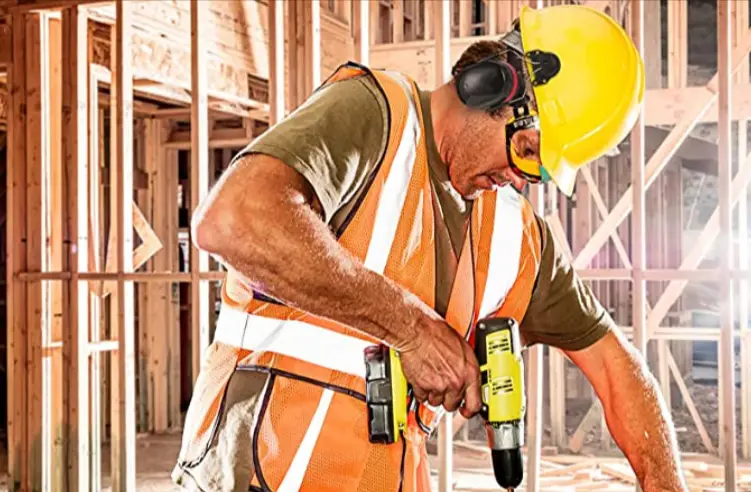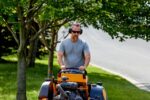We invited a group of construction pros and industrial tradesmen to test our selection of earmuffs that need to be mounted on a hard hat and give us the lowdown on which ones work best and why. In the end, we came up with two top choices for you.

Our top choice in earmuffs is BJKing 004 Noise Reduction Safety Earmuffs for Hard Hat Attachment because of the excellent NRR of 34/28 and the ample compatibility for mounting on hard hats. However, we have included a top choice in earplugs as well.
Some of our team of professionals preferred to just wear a good pair of noise-reducing earplugs with their hard hats for both comfort and convenience. So, our top choice in earplugs for under a hard hat is 3M Peltor EEP-100 Earplugs because they feature noise reduction technology and have a storage case that doubles as a charger.
| Product | NRR | Mount | Style | Extras |
|---|---|---|---|---|
| BJKing 004 Noise Reduction Safety Earmuffs for Hard Hat Attachment | 34/28 dB | Widely compatible | Earmuffs | ANSI S3.19 and CE EN352-1 certified |
| 3M Peltor Earmuffs for Hard Hat Attachment X5P3E | 31 dB | Universal | Earmuffs | Excellent padding |
| 3M Peltor Worktunes Pro Cap Mount Radio Headset | 23 dB | Universal | Earmuffs | AM/FM radio |
| 3M Peltor EEP-100 Earplugs | 27 dB | – | Earplugs | Rechargeable storing case |
| Mack’s Pillow Ultra Soft Earplugs in Foam | 33 dB | – | Earplugs | Soft foam, Disposable |
A recurring question for tradesmen who need to wear a hard hat as part of their PPE in the workplace is If any earmuffs can be used together with a hard hat and will they offer full hearing protection?
Unfortunately, the answer is No. It’s not that simple. A combination of any type of earmuffs with any type of hard hat will not guarantee full protection. Now, however, manufacturers of PPE are offering earmuffs or ear cups that can be directly mounted onto a hard hat.
Yet still, not just any hard hat! Mounting slots on the hard hat need to match the clips for mounting that are found on the earmuffs. There is a growing trend for “universal” mounting slots on some brands of hard hats, but only some models and some brands have adopted this policy.
Our List of Best Ear Protection to Use with a Hard Hat
Our Top Choice
1. BJKing 004 Noise Reduction Safety Earmuffs for Hard Hat Attachment
- NRR Sound Technology
- Adjustable Headband Design
- ANSI S3. 19 & CE EN352-1 Certified
- Ideal for construction, manufacturing, maintenance, automotive, woodworking,
- Easy cap-mount Design and Wide Compatibility
Prices pulled from the Amazon Product Advertising API on:
Product prices and availability are accurate as of the date/time indicated and are subject to change. Any price and availability information displayed on [relevant Amazon Site(s), as applicable] at the time of purchase will apply to the purchase of this product.
These earmuffs offer an impressive NRR of 34 dB for canceling noise with a solid cup that easily seals in your ear and 2 layers of foam protection.
The overall NRR is 28 dB when mounted. Outer cups are in resistant ABS to handle risky environments.
These are ANSI S3.19 and CE EN352-1 certified. Ideal for construction and heavy industry where noise is loud.
Pros
-
-
- Easy mount with wide compatibility
- ANSI certified
- NRR 34/28 dB
- Impact resistant
-
Cons
-
-
- Not for full brim hats
-
Competitive Alternative Choices
2. 3M Peltor Earmuffs for Hard Hat Attachment X5P3E
- HIGH ATTENUATION
- ADVANCED TECHNOLOGIES
- COMFORTABLE Wide, soft foam ear cushions
- DURABLE
- REPLACEABLE CUSHIONS and inserts help keep them clean
- Industrial/occupational uses only, Not for consumer sale or use
Prices pulled from the Amazon Product Advertising API on:
Product prices and availability are accurate as of the date/time indicated and are subject to change. Any price and availability information displayed on [relevant Amazon Site(s), as applicable] at the time of purchase will apply to the purchase of this product.
These 3M Peltor earmuffs offer an impressive NRR of 31 dB for exposure to hazardous noise. The ear cups tilt to ensure comfort and feature cushions made of soft foam. These cushions are replaceable.
The outer plastic cup is manufactured in resistant ABS that is impact resistant. Designed to protect from industrial and construction noise, they fit most industrial hard hats with slots as they come with a universal mounting attachment.
Pros
-
-
- Excellent padding
- Great noise protection
- NRR 31 dB
- Universal mounting attachment
-
Cons
-
-
- Somewhat heavy
- Some concerns about use with full brim hard hats
-
3. 3M Peltor Worktunes Pro Cap Mount Radio Headset
- Professional-quality hearing protection (23Db nrr)
- Am/fm radio headset with built in antenna to prevent snagging on equipment
- Store up to 5 stations so you dont miss your favorite station
- 3.5 mm listen only stereo input (limited to 82 db) for connection to external devices (e.G. Cell phone, two-way radio, ipod)
Prices pulled from the Amazon Product Advertising API on:
Product prices and availability are accurate as of the date/time indicated and are subject to change. Any price and availability information displayed on [relevant Amazon Site(s), as applicable] at the time of purchase will apply to the purchase of this product.
These ear protectors allow you to listen to an AM/FM radio while you work. 5 Stations can be stored for future listening.
A 3.5 mm audio stereo jack allows you to listen to music or podcasts from other devices. Listening only. NRR is 23dB. Designed for a cap-style hard hat.
Pros
-
-
- Safe volume management
- Two AA batteries
- NRR 23 dB
- AM/FM radio
-
Cons
-
-
- Expensive
- Not designed for a full brim cap
-
4. 3M Peltor EEP-100 Earplugs
- PROTECT YOUR HEARING
- EXTERNAL MICROPHONES
- COMFORTABLE
- EASY TO USE
- RECHARGEABLE LI-ION BATTERY
- BUILT TOUGH for the working professional. Water and dust resistant (IP54)
- VERSATILE
Prices pulled from the Amazon Product Advertising API on:
Product prices and availability are accurate as of the date/time indicated and are subject to change. Any price and availability information displayed on [relevant Amazon Site(s), as applicable] at the time of purchase will apply to the purchase of this product.
For those who prefer an earplug, this earplug kit is quite attractive for worksites that require a hard hat because it features triple C ear tips for the plugs that offer an NRR of 27dB which means your ears will be protected up to 97dB on the job.
However, they also permit you to hear normal conversations, meaning that you will know what’s happening around you. The plugs have a button for switching them on or off and the earbuds are rechargeable. The storage case doubles as a recharging unit.
Pros
-
-
- Easy to use
- Recharging storage case
- NRR 27 dB
- Water and dust resistant
-
Cons
-
-
- Expensive
- Some recharging difficulties reported
-
5. Mack’s Pillow Ultra Soft Earplugs in Foam
- ULTRA COMFORTABLE - Made with super low-pressure, slow release, Comfy Cush Comfort Foam.
- ULTRA NOISE BLOCKERS – With a Noise Reduction Rating (NRR) of 33 decibels, these versatile, noise blocking earplugs
- MADE IN THE USA
Prices pulled from the Amazon Product Advertising API on:
Product prices and availability are accurate as of the date/time indicated and are subject to change. Any price and availability information displayed on [relevant Amazon Site(s), as applicable] at the time of purchase will apply to the purchase of this product.
These Mack’s Earplugs are an attractive option for pros who prefer disposable earplugs. Made in very soft foam, they adapt perfectly to your ear canal guaranteeing comfort.
They come in boxes of 100 or 50 pairs. The NRR is 33dB which is high for earplugs. An advantage to choosing earplugs is that they can be worn under hard hats and with goggles and masks without difficulty and are a great solution for hygienic concerns.
Pros
-
-
- Convenient
- Ultra-soft
- NRR 33dB
- Can be worn with other PPE
-
Cons
-
-
- Some comments about a change in design
-
Can you mount earmuffs on all hard hat style?
One of the issues that came to our attention was how to mount earmuffs or wear earmuffs with hard hats that have a full brim style. With a cap stye brim, this was less of a problem.
Now, however, this has become less of a problem thanks to the design of mounting slots in tandem with the design of mounting hardware for earmuffs.
Of course, it is still necessary to verify if your hard hat has this feature and if the earmuffs you choose for hearing protection have an adequate NRR for your work environment.
How Noisy Is Too Noisy?
Environmental noise in the workplace is well documented and recognized as a major hazard to your health. Professionals that sustain exposure to loud noise without protection may end up with either temporary or permanent hearing loss. The amount of protection you require must match the amount of hazardous noise you are exposed to.
Noise level is measured in decibels often written as dB. OSHA (Occupational Safety and Health Administration) considers any level of noise that exceeds 85 dB is dangerous and most likely damaging to a worker’s hearing.
OSHA recommends that hearing protection be used if the noise levels exceed 85 dB. Regular exposure to any noise above 85 dB will subject a worker’s hearing to damage beyond repair.
A noise dosimeter can be used by employers and companies to measure the environmental noise that workers sustain while at work. These are small devices that can be worn attached to a belt with a small microphone attached to a lapel or collar. The noise dosimeter can measure potential noise hazards.
Employers can also organize audiometric exams for workers that function as a surveillance safety program. This testing should be done annually to measure if an employee’s hearing has deteriorated as well as if the PPE used in the workplace is doing its job.
Environmental Noise. You need ear protectors for environmental noise. The best hearing protection should be selected specifically for the environmental noise at your workplace, especially when dealing with automation, power tools, and heavy machinery, or similar.
Noise Attenuation diminishes noise energy. The amount of noise attenuation of any ear protection will be your priority when selecting your ear defenders. “NRR” stamped on the earmuffs or earplugs signifies “Noise Reduction Rating” and will show the amount of noise attenuation available with that ear protector.
The NRR is the most important piece of information you need when selecting. The higher the number, the more the environmental noise will be reduced when the ear protectors are worn correctly.
To calculate how much acoustic pressure your ears are subjected to, subtract the NRR from the average daily or weekly noise level measured at your workplace.
Noise measuring about 110 dB and ear protectors with an NRR of 30, means the average acoustic pressure you experience with the protectors will be 110 – 30 = 80 decibels. The higher the NRR, the better the noise attenuation.
Consider this table of noises and risk exposure:
| Decibel
measurement |
How long it is safe to listen without any ear protection | Type or source of the Noise |
| 130 | 0 | Jet lift off |
| 120 | 0 | Amplified musical event |
| 115 | Under one minute | Sporting event |
| 109 | Under two minutes | Use of auto horn |
| 106 | Under four minutes | Personal music source set at the maximum volume |
| 100 | Fifteen minutes | Industrial machinery |
| 97 | Half hour | Motorcycle noise |
| 94 | One hour | Electric drill |
| 91 | Two hours | Lawnmower noise |
| 85 | Eight hours | Vacuum cleaner noise |
| 55 | Always safe | Normal conversation without shouting |
What to Consider When Purchasing Ear Protectors for Hard Hats
When you select earmuffs for hard hats, three fundamentals must be considered:
-
-
- Is the NRR appropriate for the noise you sustain in the workplace?
- Is the hard hat appropriate for the risks you may run at work?
- Can the correct earmuff with an appropriate NRR for your work be mounted onto the appropriate hard hat?
-
Safety Certification. Identification stamps and markings that appear on PPE such as CE, EN ISO, and BS will show if your equipment meets necessary safety standards for the type of work you do.
There are differing standards for various types of noise. EN60745 markings refer specifically to the noise made by portable power tools while BS EN ISO 4871-2009 refers to noise from machinery.
The USA Noise Reduction Rating – NRR, the British Standards Institution – BSI, and the European Union – CE show measurements that state the protection offered.
If several options in ear defenders exist for your style and brand of hard hat, also consider these characteristics when selecting:
Allergies and sensitivities. Always check construction materials used in manufacturing and specifically those that come into direct contact with your skin if you have either allergies or sensitivities.
Fit and Comfort. Try, if at all possible, to mount the ear protectors on your hard hat and try them on before deciding. The fit must be correct to guarantee full protection and ensure your comfort. If you wear ear protection for an extended period, protectors should be comfortable.
Durability Look for quality construction materials like foam, silicone, or ABS. Consult customer feedback regarding durability with proper maintenance care. Some ear defenders come with a warranty. Consult your colleagues as well.
Cost. Quality is important. Consider spending more if it is in your best interests. Do not buy ear protectors because they are cheap. Your hearing is priceless and should be protected at all costs.
Remember that manufacturers of both hard hats and ear protectors do not allow modifications on their products when guaranteeing safety, so you must purchase ear protectors that can be mounted onto your hard hat.
The amount of protection will also depend on the seal the earmuff or ear cup forms around your ear. Pay attention to the material used in the cushioning as well as if the ear cup has a trim that facilitates forming a seal when worn.
See also: Best Hard Hat for Construction Workers
Earplugs are an option.
Disposable earplugs are a good choice for people with hygienic concerns. If you choose disposable earplugs, they are pretty inexpensive, very lightweight, and often quite adaptable to various ear canal shapes and sizes.
They also are a viable option at any temperature. The NRR number will indicate if they are adequate for a factory environment.
Reusable earplugs are also a viable choice if you don’t want to mount earmuffs. They may also prove to be a better economical choice in the long run. The market now offers earplugs with noise-canceling technology.
This technology cancels dangerous noise but will still allow you to hear conversations with colleagues if this is necessary to your work or also to your safety in the work environment. These will tend to be a bit more expensive. This technology can also be found in earmuffs.
FAQs
If I already have substantial permanent hearing loss, do I still need ear protectors?
The OHSA in 2004 determined that there is no exception for wearing hearing protection if for employees that have diminished hearing capacity or have been diagnosed as deaf. So, yes you need to wear PPE for your ears.
Can I use my hearing aid as an ear protector?
Only if you are subject to very moderate noise. They may have some technology for noise reduction, but it probably does not offer more than 20 dB. Plus, hearing aids fit more loosely and do not seal the ear.
Can I wear my hearing aid under protective earmuffs?
Yes, probably although you may need to lower the hearing aid capacity. Also, earmuffs contribute to heat and perspiration, so you may need to dehydrate your hearing aid after work each day to protect the microcircuitry present in the aid.
The Bottom Line
If you need a hard hat, it goes without saying that you also probably need hearing protection!








